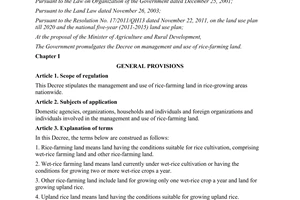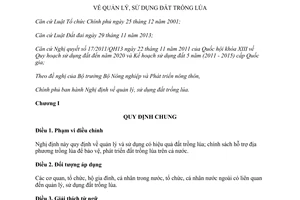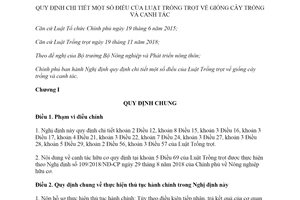Nội dung toàn văn Decree No. 35/2015/ND-CP management and use of paddy land
|
THE
GOVERNMENT |
SOCIALIST
REPUBLIC OF VIETNAM |
|
No. 35/2015/NĐ-CP |
Hanoi, April 13, 2015 |
DECREE
MANAGEMENT AND USE OF PADDY LAND
Pursuant to the Law on Government organization dated December 25, 2001;
Pursuant to the Law on Land dated November 29, 2013;
Pursuant to the Resolution No. 17/2011/QH13 dated November 22, 2011 of National Assembly, Session XIII on land-use planning till 2020 and land-use planning in five-year period (2011 – 2015) at national level;
At the request of the Minister of Agriculture and Rural Development,
The Government promulgates the Decree on management and use of paddy land.
Chapter I
GENERAL PROVISIONS
Article 1. Governing scope
This Decree regulates management and effective use of paddy land; policies supporting rice cultivation for protection and development of paddy land across the country.
Article 2. Regulated entities
Agencies, organizations, households and individuals at home, organizations and individuals abroad concerning management and use of paddy land;
Article 3. Interpretation of terms
In this Decree, some terms are construed as follows:
1. Paddy land means the land that is suitable for rice cultivation including land for growing wet rice and other types of rice.
2. Wet rice land means the land that yields from two crops of wet rice and over in a year.
3. Land for growing other types of rice includes other types of wet rice land and land for growing upland rice.
4. Land for growing the remaining wet rice means the land that is suitable for only one crop of wet rice in a year.
5. Pollution to paddy land means activities of injecting into the land toxins, harmful microorganisms and parasites that cause changes to structures and components of land, adversely affect rice production and quality, health of human beings, animals and environment.
6. Degradation to paddy land means activities causing sheet erosion, silting, aridification, salinization, acidification, aluming to the land making it less fertile and lose balance of nutrients that result in productivity reduction.
7. Distortion of paddy land surface means activities that cause changes to surface of paddy field making it uneven in structure, components of nutrients and in microorganism system and impossible for growing rice.
8. Annual plant means a plant that is sown, harvested and completes its cycle of production within one year, including annual plants with roots retained for harvesting not exceeding five years.
9. Perennial plant is a plant that is sown once, grows and harvested for years.
10. Combination with aquaculture on paddy land means the combination of rice cultivation and aquaculture: including a rice crop and then an aquacultural crop, or developing rice and aquaculture simultaneously.
Chapter II
MANAGEMENT AND USE OF PADDY LAND
Article 4. Conversion of plant mechanism on paddy land
1. Conditions for converting rice cultivation into annual plant cultivation or rice cultivation in combination with aquaculture:
a) Retain conditions for re-cultivation of rice, stop such activities as distortion of land surface, causing pollution and degradation to paddy land, causing damage to traffic construction and irrigation works serving rice cultivation;
b) Must conform with the plan for converting plant mechanism from rice cultivation to annual plant cultivation or rice cultivation in combination with aquaculture on the paddy land of commune level (hereinafter referred to as conversion of plant mechanism on paddy land);
c) In case rice cultivation is combined with aquaculture, a maximum of 20% of the rice cultivation area is set aside for aquaculture but can be restored to its normal condition for rice cultivation.
2. Land users should register for conversion of plant mechanism on paddy land with People’s committees of communes. People’s committees of communes must consider conformity with the conditions as prescribed in Clause 1 of this Article upon receipt of the registration form and monitor use of paddy land.
3. Paddy land subject to conversion of plant mechanism that meet the provisions set out in Clauses 1, 2 of this Article is still considered as paddy land unless area of paddy land is totally converted into annual plant cultivation or aquaculture.
4. The Ministry of Agriculture and Rural Development shall provide specific guidance on this Article.
Article 5. Conversion of wet rice land into non-agricultural land
1. Persons who have land allocated or rented out by the state to use for non-agricultural purpose from wet rice land must exercise regulations of the Law on Land and pay an amount of money for protection and development of paddy land.
2. Depending on specific condition in the locality, People’s committees of provinces shall decide a specific amount that is not less than 50 per cent of the amount determined by multiplying the area of wet rice land subject to conversion into non-agricultural land by the price of paddy land according to the price list at the date of conversion.
3. Persons who have land allocated or rented out by the state must make the declaration of the amount to be paid in proportion to the area of paddy rice land allocated, rented out by the state and transfer it to provincial state budget as regulated.
Article 6. Responsibilities of paddy rice users
1. Use land in accordance with use purpose as prescribed in paddy land using planning approved by competent agencies;
2. Make effective use of paddy land without causing pollution, degradation to it and abandoning it as wasteland. In case some violation is committed, penalty shall be imposed in accordance with the Law on Land.
3. Meet requirements for cultivation technique, implement rotational crops to improve production efficiency; renovate and enrich paddy land, protect eco-system environment;
4. Paddy land users must exercise their rights and obligations during land use term according to the law on land and other applicable regulations.
5. When conversion of plant mechanism on paddy land is done:
a) Register with People’s committees of communes as prescribed in Clause 2, Article 4 of this Decree;
b) Do not leave damage inflicted on irrigation, interior field traffic system causing negative effects on rice production in neighboring areas;
c) In case irrigation, interior field traffic system is damaged, take appropriate measures and make compensations if the damage does cause adverse effects on rice production in neighboring areas;
d) In case land is salinized during saltwater aquacultural cultivation, take appropriate measures to restore it to the conditions suitable for growing rice right after aquacultural cultivation.
6. When conversion of paddy land use purpose is done:
a) Comply with the regulations of the Law on Land in conversion of use purpose and provisions set out in Article 5 of this Decree;
b) Take measures to prevent and combat pollution and degradation caused to soil, water without any adverse effect on rice production in neighboring areas; Take timely measures and make compensations in case adverse effects are caused;
Chapter III
POLICIES SUPPORTING PROTECTION AND DEVELOPMENT OF PADDY LAND
Article 7. Supporting local rice production
1. Based on area of paddy land, the State shall prioritize supports for rice cultivation in the localities (including expenses for investment and regular expenses) via state budget's allocation limit decided by competent authorities according to the Law on State Budget.
2. Apart from the supports from state budget according to applicable regulations, relevant localities still enjoy other supports as follows:
a) VND 1,000,000/ha/year as supports for wet rice land;
b) VND 500,000/ha/year as supports for other wet rice land except upland rice land that is extended spontaneously without compliance with paddy land using planning;
3. Area of paddy land is supported and determined according to statistical figures on land by central-affiliated cities and provinces announced by the Ministry of Natural Resources and Environment in the year immediately prior to the year of budget allocation.
4. Supports for reclaimation and renovation of paddy land:
a) VND 10,000,000/ha as supports for paddy land (except upland rice land) that is reclaimed from unused land or restored from abandoned state. In case of multiple regulations, apply the principle each piece of land is supported once and level of support is decided by People’s committees of provinces;
b) VND 5,000,000/ha as supports for wet rice land that is reclaimed from one-crop wet rice land and other lands according to paddy land using planning;
5. Sources and supporting mechanism:
a) 100 per cent as level of support for the localities that receive source of expenses as supplements from central budget and provincial budget of Quang Ngai;
b) 50 per cent as level of support for the localities that regulate division revenues (less than 50 per cent) to the central budget;
c) The remaining localities shall use local budget for implementation.
6. People’s committees of provinces shall manage and allocate supporting budget sources for protection and development of paddy land.
Article 8. Use of supportive budget
People’s committees of all levels shall use expenses paid by persons who have land allocated, rented out by the state for non-agricultural purpose from wet rice land and the supportive budget as prescribed in Clause 2, Article 7 hereof to carry out protection and development of paddy land in conformity with local conditions:
1. Do the planning, establish maps of high productive and quality wet rice land in conformity with land using planning; make public announcement for implementation;
2. Analyze chemical and physical properties of high productive and quality wet rice land on a ten-year basis to make effective use and take appropriate renovation measures;
3. Carry out renovation to increase quality of wet rice land or other types of wet rice land: increase thickness of cultivation layers; fill in low-land areas; increase evenness of paddy field; put down organic, micro-organic fertilizers; deacidify and desalt soil contaminated with acid sulfate and salinity and other renovation measures.
4. Carry out construction and maintenance of agricultural and rural infrastructure construction works on the administrative division of communes of which traffic and irrigation system on paddy land are prioritized;
5. Carry out reclaimation and restoration of unused land to wet rice land or other kinds of wet rice land;
6. Provide direct supports to rice farmers for applying new breeds, technical and technological advances in rice production; provide supports for combination of production and consumption of products;
Chapter IV
IMPLEMENTATION
Article 9. The Ministry of Agriculture and Rural Development
1. Instruct organization of rice production and conversion of plant mechanism on paddy rice according to provisions set out hereof and other relevant documents;
2. Instruct implementation of subject matters as prescribed in Article 4 hereof;
3. Construct projects, policies supporting conversion of plant structure on paddy land and make submission to competent authorities for approval;
Article 10. Ministry of Natural Resources and Environment
1. Summarize and balance the demands for using paddy land by the Ministries, departments and central-affiliated cities and provinces; plan allocation of criteria of paddy land use at national level to socio-economic areas and provincial administrative units of which demands for using paddy land, area of paddy land converted must be specified;
2. Provide guidance to People’s committees of central-affiliated cities and provinces on determination of area and borderlines of paddy land on-site and establishment of maps of paddy land;
3. On an annual basis, summarize and make the report to the Prime Minister on the management and use of paddy land by the localities;
4. Take the initiative in cooperating with the Ministry of Agriculture and Rural Development and relevant ministries, departments in investigating and inspecting the management and use of paddy land by the localities across the country;
Article 11. Ministry of Finance
1. Balance budget source to support rice production by the localities
2. Take the initiative in cooperating with the Ministry of Planning and Investment, the Ministry of Agriculture and Rural Development in allocating budget sources to local rice production;
3. Take the initiative in cooperating with the Ministry of Agriculture and Rural Development in instructing payment, management and allocation of revenues as prescribed in Article 5 and supportive budget as prescribed in Clause 2, Article 7 hereof;
Article 12. Other ministries, departments
Other ministries, departments within assigned functions and duties shall be responsible for cooperating with the Ministry of Agriculture and Rural Development, the Ministry of Natural Resources and Environment, the Ministry of Finance, the Ministry of Planning and Investment in exercising relevant provisions set out hereof.
Article 13. People’s committees of central-affiliated cities and provinces
1. Exercise subject matters of management and use of paddy land by the localities according to provisions set out hereof and other relevant documents;
2. Organize public announcement and close management of the approved paddy land use planning; verify borderlines and establish maps of area of paddy land and high productive, quality wet rice land;
3. Presidents of People’s committees of central-affiliated cities and provinces shall be responsible to the Law and the Government for protecting area, borderlines and quality of paddy land under the approved paddy land using planning.
4. Determine types of annual plants or aquatic life appropriate for conversion of plant mechanism on paddy land in the localities as prescribed hereof; Direct professional agencies to construct the plan for implementing conversion of plant mechanism on paddy land in the localities;
5. Manage and make effective use of paddy land in reliance on particular conditions in the localities and other supporting policies in addition to provisions set out hereof;
6. On an annual basis, report to the Ministry of Natural Resources and Environment on the management and use of paddy land by the localities; report to People’s Council of the same level on the allocation and use of budget for the protection and development of paddy land;
7. Investigate and inspect the management and use of paddy land by the localities;
Chapter V
IMPLEMENTATION
Article 14. Provisional provisions
Policies supporting local rice production and rice farmers as prescribed in Articles 10, 11 of the Decision No. 42/2012/NĐ-CP remain effective till the end of December 31, 2015.
Article 15. Implementation
1. This Decree replaces the Decree No. 42/2012/NĐ-CP dated May 11, 2012 on management and use of paddy land and takes effect since July 01, 2015.
2. The Ministers, heads of ministerial-level agencies, heads of governmental agencies, presidents of People’s committees of central-affiliated cities and provinces, and other relevant organizations, individuals shall be responsible for executing this Decree ./.
|
|
PP THE
GOVERNMENT |
------------------------------------------------------------------------------------------------------
This translation is made by LawSoft and
for reference purposes only. Its copyright is owned by LawSoft
and protected under Clause 2, Article 14 of the Law on Intellectual Property.Your comments are always welcomed






